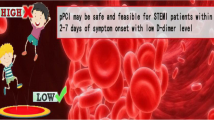Abstract
It has been reported that the increase of plasminogen activator inhibitor-1 activity immediately after elective coronary angioplasty is related to subsequent clinical recurrence in patients with chronic coronary artery disease. The aims of our study were to evaluate the behaviour of plasminogen activator inhibitor-1 and d-Dimer after revascularization in acute myocardial infarction patients treated with angioplasty and stenting and if this behavior is predictive of subsequent clinical recurrence. d-Dimer and plasminogen activator inhibitor-1 activity were evaluated in two groups of patients. Group 1 consisted of 54 consecutive patients undergoing primary angioplasty for acute myocardial infarction and Group 2 consisted of 48 patients undergoing elective angioplasty. Patients underwent control coronary angiography only in the case of clinical recurrence and/or positivity of provocative tests. d-Dimer and plasminogen activator inhibitor-1 baseline levels were significantly higher in group 1 than in group 2 (P<0.0005 and P<0.05, respectively). The percentage of group 1 patients with a post-procedural increase in d-Dimer was significantly higher among those with subsequent clinical recurrence with restenosis (61%) than among those with no recurrence (25%, P<0.05). No difference was observed in group 2. The percentage of group 2 patients in whom no decrease of plasminogen activator inhibitor-1 was observed after angioplasty was significantly higher (83%) among those with subsequent recurrence than among those with no recurrence (38%, P<0.05). This pattern was not observed in group 1. In conclusion, the role of early changes in plasminogen activator inhibitor-1 in predicting clinical recurrence after primary angioplasty in acute myocardial infarction patients is less clear than that observed after elective angioplasty. A significant role seems to be played by a more-marked clotting activation with increased fibrin formation.
Similar content being viewed by others
Author information
Authors and Affiliations
Additional information
Received: 13 September 2001 / Accepted: 19 December 2001
Rights and permissions
About this article
Cite this article
Prisco, D., Antonucci, E., Fedi, S. et al. d-Dimer increase after percutaneous transluminal angioplasty and clinical recurrence after primary revascularization in acute myocardial infarction? A pilot study. Clin Exp Med 1, 219–224 (2001). https://doi.org/10.1007/s102380100006
Issue Date:
DOI: https://doi.org/10.1007/s102380100006




